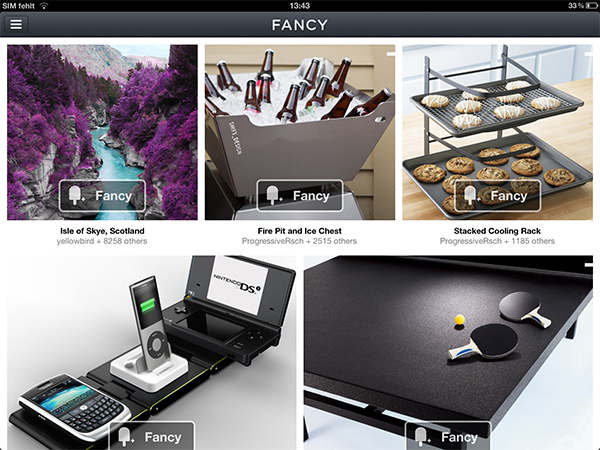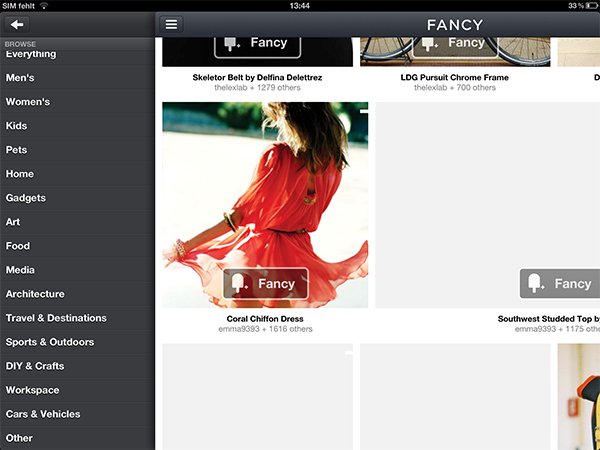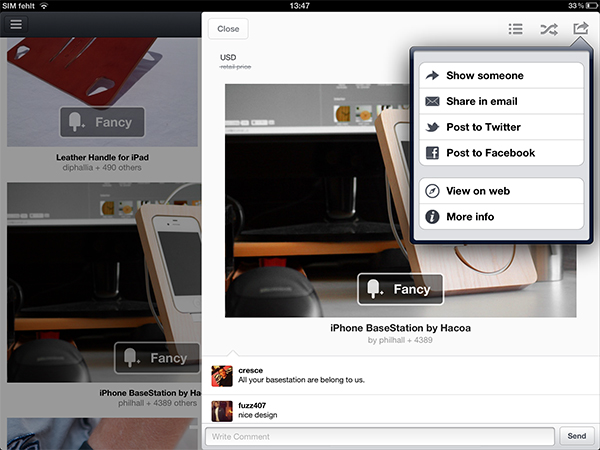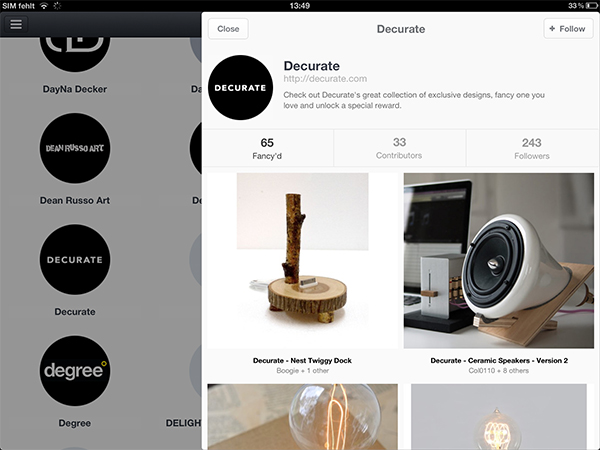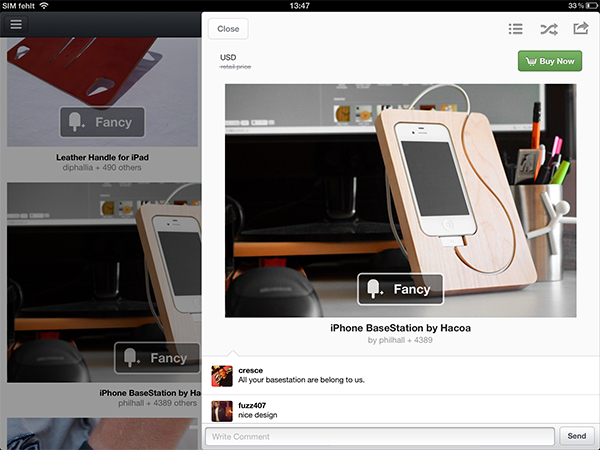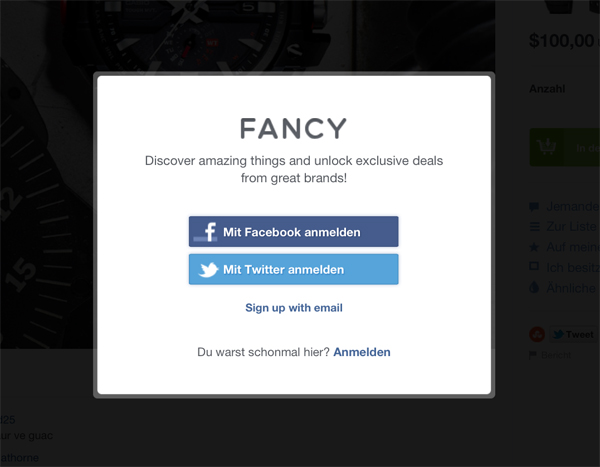Why exactly is creating new social networks still hip? In times where Facebook and Twitter are the central points in our social web life, new competitors seem to be doomed to fail the second they are unveiled. You need a huge, mind-blowing new idea with new UI features and ideas to be really unique and not seem to just copy and rename existing features like sharing options, like buttons, retweets, and followers. To be honest, I’ve never seen a product reaching this. And although it features great content and a quite elaborate iPad app environment, the network called Fancy (it’s been around since 2010, but still did not rise to real big prominence) is not an exception from that.
So why writing a post on Fancy, if it’s nothing new concerning UI and customer features? Because sometimes you don’t have to be unique in designing nice interfaces – you just let your content speak for you. On the interface side , Fancy follows the Facebook/Twitter concept of having friends, liking (here called “Fancying”) stuff, and saving it for later. But the service distinguishes itself via the content and the idea of combining the advantages of social networks with selling products to create a special mobile shopping experience.
Fancy’s content is - who could’ve guessed that - all about fancy products. Using over 15 different categories from Art over Gadgets (one I liked very much) to clothing, the app showcases products of a vast variety of independent online resellers like Decurate or more well-known ones like American Apparel. After logging in with Facebook/Twitter or a new Fancy account, you can browse the products in various ways: the mentioned categories, a Facebook feed-like “trend” timeline with the currently most viewed products (the images take some time to load), a listing of all stores that share their products on Fancy, and a “deals” area (whose use I didn’t really get since it just shows less stores and products than the store section, but doesn’t inform about any kind of deals). Once you find a product, you can share your discovery with friends who are already using Fancy via Twitter, Mail, and Facebook, or add it to an in-app shopping cart to buy it (I’ll dive in to that a bit later on). Different from the rest of the app, the developers forgot to update the respective list pictograms in some parts to Retina resolution; to me, this is an inexcusable flaw showing that the designers didn’t perfectly curate every detail of the UI.
If the service does curate one thing right, that’s the content. The people behind Fancy must have a great taste of contemporary, interesting products, such as clothing and industrial design as a whole. Not a single fancy product in the app is not something very unique and extraordinary. And all shops and resellers within the Fancy network are thoughtfully chosen; most of them are proud of being part of it and even have “Fancying” buttons on their website.
Let’s come back to comparing the app to other social networks. Not just in the basic features, but even the (fortunately Retina-optimized) UI is similar to the mobile Facebook app. Fancy uses a paneled layout with a sidebar used to reach more filtering options. The fancy products are then displayed in square areas, arranged like 500px photography - you see, the app copied some of others’ best UI ideas and intelligently combined them with a large amount of white space to gently focus the user’s attention on the content.
The problem is, the UI does not really correspond to the content and is not executed well in too many areas of the app. Just let me give two striking examples: when selecting a product or a store to investigate it in detail in the main window (which occupies the whole screen) new content is displayed in a new panel which slides in. In portrait mode, everything is divided up greatly, but unlike in other apps like Spotify, in landscape mode, the new panel occupies just about 60 percent of the window, leaving a large area unused on its left (see screenshots above). This can get very annoying, especially when you look at single products, whose preview images are way smaller than in the main window.
Secondly, with such a large amount of cool stuff, you’d want to save some for later. Fancy offers a list feature for that. Using the app for the first time, however, you’ll ask yourself if this feature actually exists. The lists are hidden in a top button within the single product view. Understandable, since this is the point where you consider saving something you found for later or not. I’d love to have lists available for later investigation in the slide-in side navigation bar as well, though.
Unfortunately, I’m still not through with pointing out flaws in Fancy, although I like the idea and the content very much. But if you offer a shopping feature in an app, please make it work in every country you offer the app, or at least mention somewhere in the app that in only works in certain areas of the world. When you open a single product page in Fancy here in Germany, you just get a “US-Dollar” indicator, but no price at all. After I saw this, I thought I could open Safari to get more info. When tapping the “view on web” button, you firstly get a badly integrated browser, which is extremely slow, and if you decide to open the page in Mobile Safari, you are lead to the Fancy website, which doesn’t display the product with a link to its original page; you are confronted with a login window instead, forced to log yourself in again (although you already did it via the app) before you can take a look at the product (see below).
Because of this lack in using Fancy as a usable shopping opporturnity, I stick to it as a tool to discover cool online shops selling interesting stuff. After I find some interesting shops, I stop browsing Fancy, and go to the respective reseller websites with Mobile Safari (the links are shown, but they are not clickable within Fancy) to continue there. But obviously, this is not the idea of an all-in-one social network Fancy apparently wants to be. To become that, the app needs a lot of updated features and a more useable UI. The content is great though, and so you should still download Fancy for free on the App Store and build up your own opinion about it.


